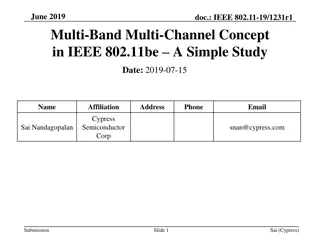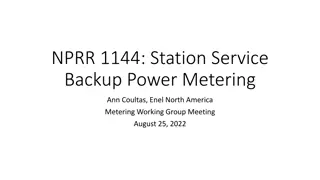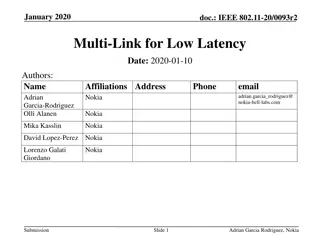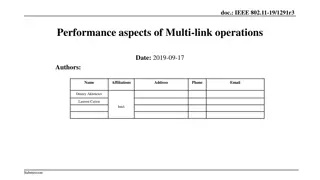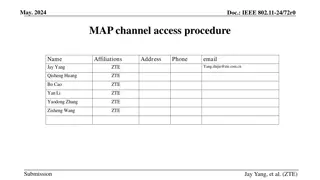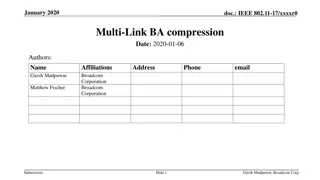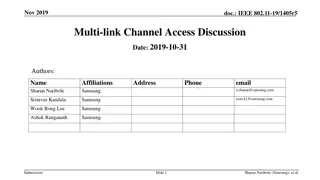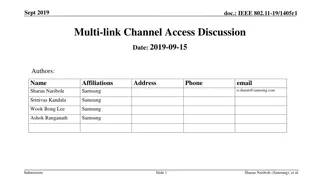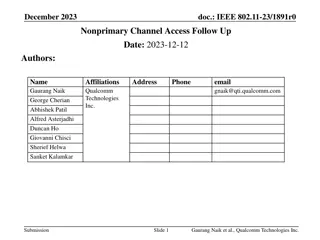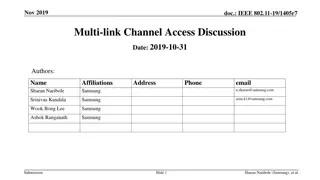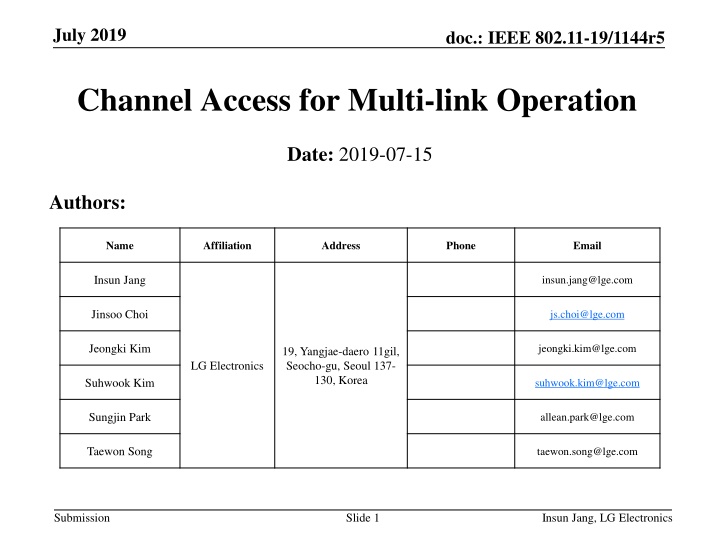
Channel Access for Multi-link Operations in IEEE 802.11-19/1144r5 Document
Explore the modes of multi-link operation and channel access discussed in the IEEE 802.11-19/1144r5 document for Asynchronous and Synchronous modes, enabling insights into peak throughput enhancement through multi-link aggregation. Considerations for reducing interference and utilizing common Traffic ID for efficient transmission across multiple links are highlighted.
Download Presentation

Please find below an Image/Link to download the presentation.
The content on the website is provided AS IS for your information and personal use only. It may not be sold, licensed, or shared on other websites without obtaining consent from the author. If you encounter any issues during the download, it is possible that the publisher has removed the file from their server.
You are allowed to download the files provided on this website for personal or commercial use, subject to the condition that they are used lawfully. All files are the property of their respective owners.
The content on the website is provided AS IS for your information and personal use only. It may not be sold, licensed, or shared on other websites without obtaining consent from the author.
E N D
Presentation Transcript
July 2019 doc.: IEEE 802.11-19/1144r5 Channel Access for Multi-link Operation Date: 2019-07-15 Authors: Name Affiliation Address Phone Email Insun Jang insun.jang@lge.com Jinsoo Choi js.choi@lge.com Jeongki Kim jeongki.kim@lge.com 19, Yangjae-daero 11gil, Seocho-gu, Seoul 137- 130, Korea LG Electronics Suhwook Kim suhwook.kim@lge.com Sungjin Park allean.park@lge.com Taewon Song taewon.song@lge.com Submission Slide 1 Insun Jang, LG Electronics
July 2019 doc.: IEEE 802.11-19/1144r5 Introduction In the last meeting, Asynchronous (or independent) operation and Synchronous (or simultaneous) operation are addressed as modes of multi-link aggregation/operation [1]-[6] In this contribution, we discuss the operation and channel access for those modes Submission Slide 2 Insun Jang, LG Electronics
July 2019 doc.: IEEE 802.11-19/1144r5 Modes of Multi-link Operation Both of Asynchronous (Async.) mode and Synchronous (Sync.) mode are proper multi-link operations to increase the peak throughput by aggregating multi-links Basically, we need to consider channel access for (re)transmission using multi-link operation Submission Slide 3 Insun Jang, LG Electronics
July 2019 doc.: IEEE 802.11-19/1144r5 Enabling Asynchronous Mode In Async. mode, an 11be STA (re)transmits and receives frames on each link independently It means that simultaneous (independent) DL/UL over multi-link can happen However, Async. mode can cause the interference by out-of-band (OOB) emission unless their channels are sufficiently away [6] It mainly would occur between channels in a band (e.g., 2 channels in 5GHz) Therefore, the Async. mode will require a method for reducing the interference such as large distance between channels Submission Slide 4 Insun Jang, LG Electronics
July 2019 doc.: IEEE 802.11-19/1144r5 Channel Access in Asynchronous Mode For the Async. Mode (satisfying the requirements), each EDCA parameters set (e.g., contention window (CW), AIFSN, etc.) should be used on a primary channel of each link, independently Submission Slide 5 Insun Jang, LG Electronics
July 2019 doc.: IEEE 802.11-19/1144r5 Channel Access in Asynchronous Mode with Common TID In Async. mode, a common TID over multi-link may be supported It means traffic flows for a common TID can be transmitted on multi-link Especially, support of a common TID over multi-link enables a retransmission on some other links on behalf of the link that an initial transmission is performed for the quick re-ordering Independent EDCA on each link can support the transmission on multi-link with a common TID without any problems Submission Slide 6 Insun Jang, LG Electronics
July 2019 doc.: IEEE 802.11-19/1144r5 Enabling Synchronous Mode Sync. mode is a proper alternative not to generate the interference between links It means that simultaneous (independent) DL/UL Tx over multi-link is not supported, i.e., DL only Tx or UL only Tx over multi-link is supported Therefore, Sync. mode requires the synchronization of the timing of transmission It can have a single primary channel or multiple primary channels over multi-link Submission Slide 7 Insun Jang, LG Electronics
July 2019 doc.: IEEE 802.11-19/1144r5 Channel Access in Synchronous Mode with Single Primary Sync. mode with a single primary channel would use the original EDCA channel access over all of links to aggregate links as in the single-link For more than 160MHz, an additional rule might be needed (e.g., Secondary160) Submission Slide 8 Insun Jang, LG Electronics
July 2019 doc.: IEEE 802.11-19/1144r5 Channel Access in Synchronous Mode with Multiple Primary Sync. mode with multiple primary channels would use the original EDCA channel access in each link To facilitate aligning the timing of transmission over multi-link, it needs to design a proper channel access over multi-link For example, if BC of a link becomes zero and the channel states of other links during a certain period are idle, frames can be transmitted by using the links A certain period can be PIFS for the priority or AIFS for the fairness Submission Slide 9 Insun Jang, LG Electronics
July 2019 doc.: IEEE 802.11-19/1144r5 Discussion on Mode Operation Operation mode (Async. or Sync.) can be maintained without change, e.g., Sync. Mode only operate on several links due to interference Async. Mode only operate on several links without interference Operation mode may be changed, e.g., Async. -> Sync. -> Async. For some use cases such as applications requiring considerable amount of traffic in a short time Submission Slide 10 Insun Jang, LG Electronics
July 2019 doc.: IEEE 802.11-19/1144r5 Summary We have discussed the operation and channel access in both of Asynchronous mode and Synchronous mode Asynchronous mode can perform the independent EDCA channel access on each link even in case of a common TID Synchronous mode with multiple primary needs to perform a proper channel access to facilitate multi-link aggregation while Synchronous mode with a single primary would perform the original channel access used in a single link Submission Slide 11 Insun Jang, LG Electronics
July 2019 doc.: IEEE 802.11-19/1144r5 Straw Poll 1 Do you agree that the 802.11be amendment defines Asynchronous mode for multi-link operation? Asynchronous mode means frames are transmitted independently over multiple links by STAs belonging to a multi-link capable device regardless of downlink or uplink Note: Exact name of mode can be changed Y/N/A: 42/12/43 Submission Slide 12 Insun Jang, LG Electronics
July 2019 doc.: IEEE 802.11-19/1144r5 Motion Move to add the followings to the 11be SFD: Shall allow the following asynchronous multi-link channel access Each of STAs belonging to a multi-link device* performs a channel access over their links independently in order to transmit frames Downlink and uplink frames can be transmitted simultaneously over the multiple links NOTE*: The exact name can be changed Mover: Insun Jang Second: Y: N: A: Submission Slide 13 Insun Jang, LG Electronics
July 2019 doc.: IEEE 802.11-19/1144r5 References [1] 802.11-19/0731r0 EHT Multi-link Operation [2] 802.11-19/0766r1 Enhanced Multi-band/Multi-channel Operation [3] 802.11-19/0764r0 Multi-Link Aggregation: Gain Analysis [4] 802.11-19/0823r0 Multi-Link Aggregation [5] 802.11-19/0821r0 Multiple Band Operation Discussion [6] 802.11-18/1908r0 Overview of Full Duplex over Multi- Band (FD- MB) for EHT Submission Slide 14 Insun Jang, LG Electronics





